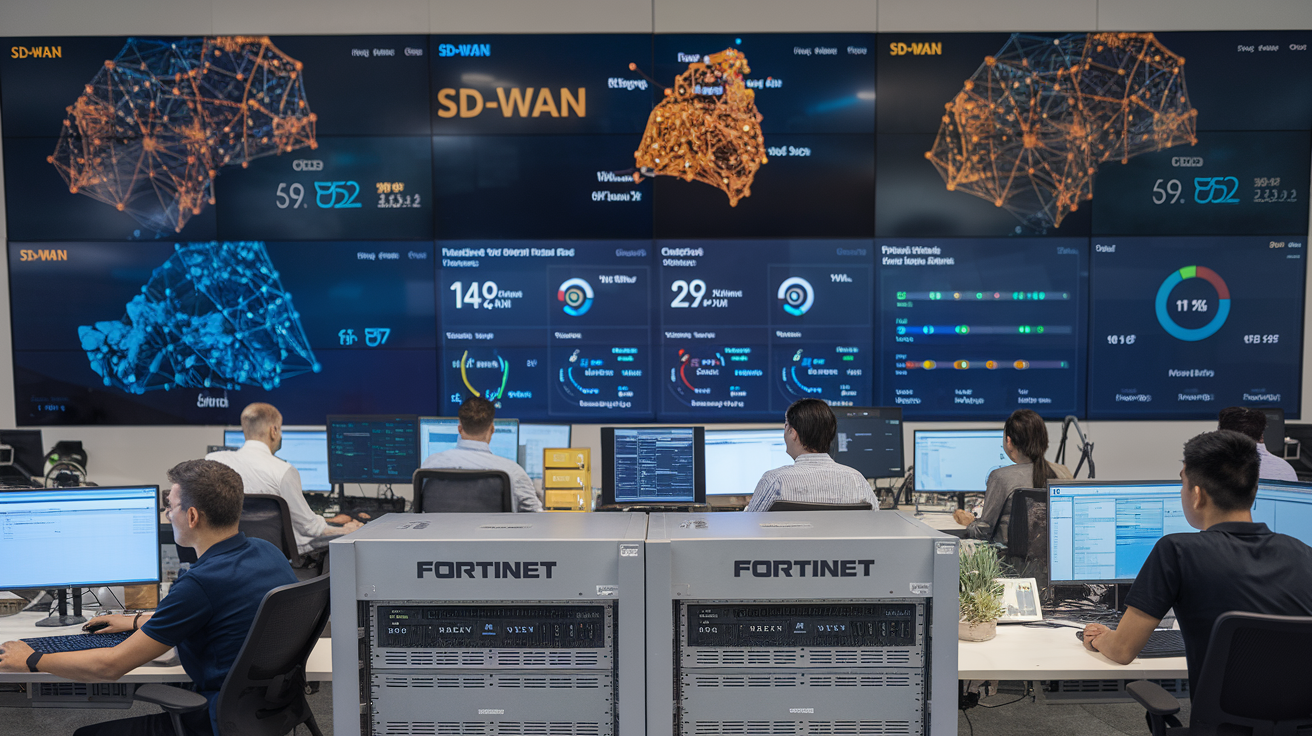Is Your SD-WAN Deployment Doomed? Avoid These 5 Fortinet Pitfalls Now!

Is Your SD-WAN Deployment Doomed? Avoid These 5 Fortinet Pitfalls Now!
Is your Fortinet SD-WAN deployment on the brink of disaster? 🚨 While SD-WAN promises to revolutionize network management, many organizations find themselves stumbling through a minefield of potential pitfalls. From initial setup headaches to scalability nightmares, the journey to a successful SD-WAN implementation can be fraught with challenges.
But fear not! 💪 Whether you’re a network engineer grappling with complex configurations or a security specialist trying to integrate robust protection, this guide is your lifeline. We’ll unveil the five critical Fortinet pitfalls that could doom your SD-WAN deployment and provide you with the knowledge to avoid them. By mastering everything from advanced routing techniques to application performance optimization, you’ll transform your network into a streamlined, secure, and scalable powerhouse.
Ready to navigate the treacherous waters of SD-WAN deployment with confidence? Let’s dive into the essential steps, from understanding Fortinet SD-WAN basics to troubleshooting like a pro. Buckle up as we explore initial setup, security integration, and the art of multi-site management – your journey to SD-WAN success starts now!
Understanding Fortinet SD-WAN

A. Key components of Secure SD-Branch framework
Fortinet’s Secure SD-Branch framework is built on several crucial components that work together to provide a comprehensive network solution. These components include:
- SD-WAN architecture
- Physical or virtual appliances
- Centralized management controllers
- Secure web gateways
- Integrated or embedded firewalls
This framework integrates LAN, SD-WAN, and routing capabilities to create a robust and secure network infrastructure. The key benefits of this approach include:
- Improved network performance through intelligent traffic routing
- Enhanced security via integrated firewalls and secure web gateways
- Simplified management and scalability
B. Integration of LAN, SD-WAN, and routing
Fortinet’s Secure SD-WAN solution seamlessly integrates LAN, SD-WAN, and routing functionalities, offering a unified approach to network management. This integration provides several advantages:
| Feature | Benefit |
|---|---|
| Centralized control | Streamlined management of traffic across diverse connections |
| Improved connectivity | Enhanced performance for remote sites and branch offices |
| Cost savings | Utilization of various connection types, reducing reliance on expensive MPLS |
The integration of these components allows organizations to optimize their network efficiency while maintaining a high level of security across all network segments.
C. FortiGate’s role in WAN intelligence and security
FortiGate plays a crucial role in Fortinet’s Secure SD-WAN solution, providing both WAN intelligence and security features. Key aspects of FortiGate’s functionality include:
- Traffic optimization: Intelligent routing of network traffic to improve performance
- Security integration: Embedded firewalls and secure web gateways for robust protection
- Centralized management: FortiManager facilitates easy configuration and policy management
- Visibility and analytics: Comprehensive monitoring of network traffic and performance
FortiGate devices are central to the SD-WAN architecture, separating control and data planes for better management and performance. This separation allows for more efficient traffic routing and enhanced security measures across the network.
With this understanding of Fortinet SD-WAN’s key components and functionality, we can now explore the initial setup and configuration process. In the next section, we’ll delve into the steps required to properly set up and configure your Fortinet SD-WAN deployment for optimal performance and security.
Initial Setup and Configuration

Now that we’ve covered the fundamentals of Fortinet SD-WAN, let’s dive into the crucial steps of initial setup and configuration. This phase sets the foundation for a successful SD-WAN deployment, ensuring smooth operations and optimal security.
A. Management access and setup wizard
The setup process begins with establishing management access to your Fortinet device. The Administration Guide provides two primary methods:
- Web browser interface
- FortiExplorer
For most users, the web browser interface offers a user-friendly approach. Once connected, you’ll be guided through the setup wizard, which streamlines the initial configuration process.
| Setup Step | Description |
|---|---|
| Device Connection | Connect via web browser or FortiExplorer |
| Setup Wizard | Follow prompts for basic configuration |
| GUI Navigation | Familiarize with dashboard and widgets |
B. Device registration and licensing
After initial access, it’s crucial to register your device and ensure proper licensing. This step is vital for:
- Accessing FortiGuard services
- Enabling full functionality of your SD-WAN solution
- Ensuring compliance with Fortinet’s terms of service
The “SD-WAN / SD-Branch Deployment Guide” emphasizes the importance of this step, particularly for scalable deployments managed through FortiManager.
C. Basic firewall policy configuration
With management access established and licensing in place, the next step is configuring basic firewall policies. This foundational security measure is critical for protecting your network edge. Key considerations include:
- Defining inbound and outbound traffic rules
- Setting up application-based policies
- Implementing security profiles
The Administration Guide provides detailed instructions for configuring these policies through both the GUI and CLI, allowing for flexibility based on your preference and expertise level.
As we transition to the next section on SD-WAN Deployment Steps, it’s important to note that a solid initial setup lays the groundwork for more advanced configurations. The basic firewall policies you’ve just established will integrate seamlessly with the SD-WAN features we’ll explore next, creating a robust and secure network infrastructure.
SD-WAN Deployment Steps

Now that we’ve covered the initial setup and configuration, let’s dive into the crucial steps for deploying your Fortinet SD-WAN solution.
A. Defining business needs and network design
Before configuring your SD-WAN, it’s essential to align your deployment with your organization’s specific requirements. Consider the following:
- Network topology
- Bandwidth requirements
- Application priorities
- Security needs
- Scalability considerations
| Consideration | Impact on SD-WAN Design |
|---|---|
| Network topology | Determines hub-spoke or mesh configuration |
| Bandwidth requirements | Influences interface selection and capacity planning |
| Application priorities | Guides traffic steering and QoS policies |
| Security needs | Informs integration of security features |
| Scalability considerations | Affects multi-site deployment strategy |
B. Configuring SD-WAN interfaces and rules
With your network design in place, proceed to configure SD-WAN interfaces and rules:
- Define SD-WAN interface members
- Group interfaces into SD-WAN zones
- Establish Performance Service Level Agreements (SLAs)
- Create SD-WAN rules for traffic management
Performance SLAs are crucial for assessing path health through metrics like latency and packet loss, enabling dynamic application steering based on real-time performance.
C. Setting up overlay VPN and ADVPN
To ensure secure and efficient communication across your SD-WAN:
- Configure IPsec VPN tunnels
- Set up Adaptive Dynamic VPN (ADVPN) for enhanced flexibility
- Implement tunnel bandwidth aggregation for improved performance
- Integrate BGP tags with SD-WAN rules for advanced routing
ADVPN enhances the scalability and efficiency of your SD-WAN deployment, allowing for dynamic spoke-to-spoke connections when needed.
With these SD-WAN deployment steps in place, your Fortinet solution will be primed for optimal performance. As we move forward, we’ll explore advanced routing techniques to further refine your SD-WAN configuration and maximize its potential.
Advanced Routing Techniques

Now that we’ve covered the essential SD-WAN deployment steps, let’s delve into the advanced routing techniques that can optimize your Fortinet SD-WAN implementation.
BGP multipath support and integration
Fortinet’s SD-WAN solution leverages Border Gateway Protocol (BGP) for efficient route advertisement and path selection. By integrating BGP with SD-WAN, network administrators can achieve:
- Dynamic routing adjustments
- Improved redundancy
- Optimal path selection
To implement BGP multipath support:
- Configure multiple VPNs between sites
- Set up health checks for each path
- Utilize BGP communities for path tagging
Here’s a basic configuration example:
config router bgp
set as 65000
config neighbor
edit "192.168.1.1"
set remote-as 65001
set route-map-in "TAG_COMMUNITY"
next
end
end
Route-maps for primary and secondary SD-WAN neighbors
Route-maps play a crucial role in managing traffic flow between primary and secondary SD-WAN neighbors. They allow for:
| Feature | Benefit |
|---|---|
| Path prioritization | Ensures critical traffic uses preferred routes |
| Load balancing | Distributes traffic across multiple paths |
| Failover mechanisms | Redirects traffic in case of link failure |
To implement route-maps:
- Create a community list
- Configure a route map
- Apply the route map to BGP neighbors
Example configuration:
config router community-list
edit "DC_COMMUNITY"
set type standard
set rule "30:5"
next
end
config router route-map
edit "TAG_COMMUNITY"
config rule
edit 1
set match-community "DC_COMMUNITY"
set set-route-tag 15
next
end
next
end
Self-healing capabilities using BGP
Fortinet’s SD-WAN solution incorporates self-healing capabilities through BGP, ensuring network resilience:
- Automatic failover to secondary paths
- Dynamic re-routing based on link quality
- Continuous monitoring of SLAs
To enable self-healing:
- Configure SD-WAN health checks
- Set up BGP neighbors with appropriate route-maps
- Implement SD-WAN rules based on route tags
Example health check configuration:
config system sdwan
config health-check
edit "DC_HC"
set server "192.168.2.1"
set sla-fail-log-period 10
set sla-pass-log-period 10
set members 1 2
next
end
end
By implementing these advanced routing techniques, your Fortinet SD-WAN deployment can achieve greater flexibility and reliability. With this foundation in place, we’ll next explore application performance optimization to further enhance your network’s efficiency and user experience.
Application Performance Optimization

Now that we’ve covered advanced routing techniques, let’s delve into application performance optimization, a crucial aspect of Fortinet SD-WAN deployment.
WAN health measurements and interface bandwidth testing
Fortinet’s SD-WAN solution provides robust tools for monitoring and optimizing WAN health and performance. By utilizing FortiGate’s built-in capabilities, administrators can:
- Conduct real-time bandwidth tests
- Monitor latency and packet loss
- Assess overall link quality
These measurements are essential for maintaining optimal network performance and ensuring efficient application delivery.
Application steering (static and dynamic)
Application steering is a key feature of Fortinet’s SD-WAN, allowing for intelligent traffic routing based on application requirements. This can be implemented in two ways:
- Static steering: Predefined rules for specific applications
- Dynamic steering: Real-time adjustments based on network conditions
| Steering Type | Advantages | Use Cases |
|---|---|---|
| Static | Predictable routing, Ideal for critical apps | VoIP, Video conferencing |
| Dynamic | Adaptive to network changes, Optimizes performance | General internet traffic, Cloud applications |
To enhance performance for time-sensitive applications like VoIP, VoD, and IPTV, Fortinet recommends configuring SD-WAN rules with specific performance Service Level Agreements (SLAs). A reduced SLA check interval of 20 milliseconds, compared to the default 500 milliseconds, can significantly improve network quality for these applications.
Adaptive Forward Error Correction (FEC) and packet duplication
Fortinet’s SD-WAN incorporates advanced techniques to mitigate network issues and enhance application performance:
- Adaptive Forward Error Correction (FEC): This technique adds redundant data to transmissions, allowing for error correction without retransmission.
- Packet duplication: Critical packets are sent over multiple paths to ensure delivery, reducing latency and improving reliability.
These features work in tandem with application steering to provide a comprehensive approach to performance optimization. By leveraging these capabilities, Fortinet’s SD-WAN can significantly reduce the impact of network issues on user experience, ensuring consistent application performance across diverse networking environments.
With this robust set of performance optimization tools in place, we’ll next explore how Fortinet’s SD-WAN handles traffic management and Quality of Service (QoS) to further enhance network efficiency and user experience.
Traffic Management and QoS

Now that we’ve explored application performance optimization, let’s delve into the crucial aspect of traffic management and Quality of Service (QoS) in Fortinet SD-WAN deployments.
Traffic shaping strategies for SD-WAN
Effective traffic shaping is essential for optimizing SD-WAN performance. Fortinet’s FortiGate devices offer robust tools for managing network traffic:
- Create traffic shaping policies to guarantee bandwidth for critical applications
- Prioritize specific types of traffic (e.g., HTTP/HTTPS over FTP)
- Implement Application Control in firewall policies
To configure traffic shaping:
- Enable SD-WAN with two members (wan1 and wan2)
- Set bandwidth for each member (e.g., 10 Mb/s)
- Create traffic shaping policies using CLI commands
| Traffic Type | Priority | Guaranteed Bandwidth |
|--------------|----------|----------------------|
| HTTP/HTTPS | High | 5 Mb/s |
| FTP | Low | 2 Mb/s |
Implementing Quality of Service (QoS) policies
QoS policies ensure that critical applications receive the necessary network resources:
- Set service priorities for different traffic types
- Configure QoS settings within the SD-WAN context
- Use both GUI and CLI for QoS implementation
Key steps for QoS implementation:
- Define traffic classes
- Assign priorities to traffic classes
- Configure QoS policies in firewall rules
- Apply QoS policies to SD-WAN interfaces
Bandwidth aggregation techniques
Fortinet SD-WAN offers advanced bandwidth aggregation to maximize network efficiency:
- Combine multiple WAN links for increased throughput
- Utilize intelligent load balancing across SD-WAN members
- Implement performance SLAs for optimal traffic routing
To monitor and diagnose traffic flow:
- Use
diagnosecommands to verify traffic shaper application - Check bandwidth management effectiveness
- Ensure proper configuration of SD-WAN rules and policies
With these traffic management and QoS strategies in place, your Fortinet SD-WAN deployment can efficiently prioritize and route network traffic. Next, we’ll explore how to integrate robust security features into your SD-WAN infrastructure, further enhancing your network’s overall performance and protection.
Security Features Integration

Now that we’ve covered traffic management and QoS, let’s delve into the critical aspect of security features integration in Fortinet SD-WAN deployments.
A. Security profiles for application control
Fortinet Secure SD-WAN offers robust security profiles for application control, aligning with the growing need for multi-cloud environments. These profiles enable organizations to:
- Implement granular control over application traffic
- Prioritize critical business applications
- Mitigate risks associated with unauthorized app usage
To effectively utilize security profiles, consider the following best practices:
- Identify and categorize applications based on business criticality
- Define policies for allowed and restricted applications
- Implement traffic shaping rules for optimal performance
- Regularly review and update profiles to address emerging threats
B. Intrusion Prevention System (IPS) configuration
FortiGate’s integrated IPS is a crucial component of Fortinet Secure SD-WAN, providing advanced threat detection and prevention capabilities. Key features include:
| Feature | Description |
|---|---|
| Deep packet inspection | Analyzes network traffic for malicious patterns |
| AI-powered security services | Enhances threat detection and response |
| Automated updates | Ensures protection against the latest vulnerabilities |
To configure IPS effectively:
- Enable FortiGuard AI-powered security services
- Customize IPS policies based on your network’s specific requirements
- Implement DNS security measures to prevent DNS-based attacks
- Regularly monitor and fine-tune IPS settings for optimal performance
C. Zero Trust Network Access (ZTNA) implementation
ZTNA is a cornerstone of Fortinet’s approach to secure SD-WAN, facilitating the transition towards a comprehensive zero-trust framework. Key aspects of ZTNA implementation include:
- Integration with FortiSASE for secure access across diverse locations
- Leveraging FortiManager and FortiAnalyzer for comprehensive visibility and analytics
- Utilizing FortiAI’s generative AI capabilities for enhanced SD-WAN management
To successfully implement ZTNA:
- Define access policies based on user identity and device posture
- Implement least-privilege access principles
- Utilize FortiGate’s NGFW capabilities for granular access control
- Leverage FortiSASE for consistent security across on-premises and cloud environments
With security features integrated, we’ll next explore the management and orchestration aspects of Fortinet SD-WAN deployments, crucial for maintaining a robust and efficient network infrastructure.
Management and Orchestration

Now that we have covered the integration of security features in Fortinet SD-WAN, let’s delve into the critical aspect of management and orchestration. Effective management is essential for maintaining a secure and efficient SD-WAN deployment.
FortiManager for centralized management
FortiManager serves as the cornerstone of Fortinet’s centralized management approach, offering:
- Comprehensive visibility into connectivity, resource utilization, and device settings
- Unified management of FortiGates across various platforms (virtual machines, cloud-native functions, and hardware)
- Consistent application of security policies throughout the organization
FortiManager’s AI-powered capabilities, driven by FortiAI, include:
- Context-aware generative AI assistant
- AI-driven recommendations
- Regularly updated automation packs
These features allow network management to focus on strategic initiatives, improving operational effectiveness.
FortiAnalyzer for logging and reporting
FortiAnalyzer plays a crucial role in enhancing network functionality and security by:
- Providing insights into WAN link availability and performance
- Offering application traffic analysis
- Facilitating troubleshooting for infrastructure teams
- Reducing IT support tickets through improved visibility
Key benefits of FortiAnalyzer include:
| Feature | Benefit |
|---|---|
| On-demand reporting | Enhances compliance management |
| Standardized templates | Identifies vulnerabilities |
| Audit checks | Aligns with regulations (e.g., PCI DSS, NIST) |
Third-party orchestration tools (Terraform and Ansible)
While Fortinet provides robust native management tools, integration with third-party orchestration platforms like Terraform and Ansible can further enhance SD-WAN deployment and management:
- Automated VPN overlay management for efficient meshed connectivity
- Enhanced analytics for monitoring WAN performance
- Tools for effective troubleshooting of network issues
These third-party tools complement Fortinet’s solutions by:
- Streamlining centralized deployment
- Enabling swift responses to business needs
- Optimizing application and traffic distribution between branch offices
By leveraging a combination of FortiManager, FortiAnalyzer, and third-party orchestration tools, organizations can achieve a more secure and agile SD-WAN infrastructure. This integrated approach to management and orchestration sets the stage for our next topic: scalability and multi-site deployment, where we’ll explore how these management tools facilitate the expansion of SD-WAN across multiple locations.
Scalability and Multi-site Deployment

Now that we’ve covered the management and orchestration aspects of Fortinet SD-WAN, let’s delve into the crucial topic of scalability and multi-site deployment. This section will explore how Fortinet’s solution addresses the challenges of expanding your SD-WAN infrastructure across multiple locations.
Single and dual hub deployment scenarios
Fortinet’s SD-WAN solution offers flexible deployment options to accommodate various network topologies. In single hub scenarios, all branch offices connect to a central hub, while dual hub configurations provide increased redundancy and load balancing capabilities.
| Deployment Type | Advantages | Considerations |
|---|---|---|
| Single Hub | Simplified management, Cost-effective | Potential single point of failure |
| Dual Hub | Increased redundancy, Better load distribution | More complex configuration, Higher cost |
For both scenarios, Fortinet’s SD-WAN leverages dynamic path selection and SLA-based routing to optimize traffic flow between spokes and hubs. This ensures that network performance remains consistent even as the number of sites increases.
Zero Touch Provisioning with FortiManager
FortiManager plays a crucial role in simplifying the deployment process for multi-site SD-WAN implementations. Zero Touch Provisioning (ZTP) capabilities allow network administrators to:
- Automate device configuration
- Streamline policy creation for health-check traffic
- Support various WAN link types
This automation significantly reduces the time and effort required to bring new sites online, making it easier to scale the SD-WAN infrastructure rapidly and efficiently.
Managed Security Service Provider (MSSP) considerations
Fortinet’s SD-WAN solution is designed with MSSPs in mind, offering several features that cater to service provider needs:
- Multi-tenancy support
- Centralized management through FortiManager
- Comprehensive visibility and analytics via FortiAnalyzer
- Flexible licensing models
These capabilities enable MSSPs to:
- Efficiently manage multiple customer environments
- Provide value-added services such as security integration and performance optimization
- Scale their offerings to meet growing demand
By leveraging Fortinet’s SD-WAN Overlay-as-a-Service, MSSPs can quickly provision and manage customer networks with minimal technical requirements, backed by Fortinet’s robust infrastructure and managed services.
As we transition to the next section on troubleshooting and maintenance, it’s important to note that the scalability features discussed here lay the foundation for efficient network management. The ability to easily deploy and manage multiple sites will prove invaluable when addressing potential issues across a distributed SD-WAN environment.
Troubleshooting and Maintenance

Now that we’ve covered the scalability and multi-site deployment aspects of Fortinet SD-WAN, let’s delve into the crucial area of troubleshooting and maintenance. Ensuring smooth operation and addressing potential issues are vital for maintaining an effective SD-WAN infrastructure.
Log analysis and debugging commands
Fortinet’s SD-WAN solution provides robust tools for log analysis and debugging, essential for identifying and resolving issues quickly. Key features include:
- Passive WAN health measurements
- Application steering (static and dynamic)
- Interface bandwidth testing
To effectively troubleshoot your SD-WAN deployment, utilize the following methods:
- Review system logs
- Use debugging commands
- Analyze application performance metrics
- Check WAN interface status
| Troubleshooting Method | Purpose | Key Information |
|---|---|---|
| System logs | Identify errors and warnings | Time stamps, error codes, affected components |
| Debugging commands | Detailed system behavior analysis | Real-time traffic flow, routing decisions |
| Performance metrics | Assess application and network performance | Latency, packet loss, bandwidth utilization |
| WAN interface status | Verify connectivity and link health | Up/down status, bandwidth, packet statistics |
Backup processes and system updates
Maintaining your Fortinet SD-WAN deployment involves regular backups and system updates. Consider the following best practices:
- Implement automated backup schedules
- Store backups securely off-site
- Test restore procedures periodically
- Plan system updates during maintenance windows
- Review release notes before applying updates
High availability configuration
To ensure continuous operation of your SD-WAN infrastructure, implementing high availability (HA) is crucial. Fortinet offers various HA configurations:
- Active-Passive setup
- Single datacenter deployment
- Seamless failover between primary and secondary devices
- Active-Active configuration
- Multi-datacenter setup
- Load balancing across multiple FortiGate devices
- Cluster-based HA
- Scalable solution for larger deployments
- Distributed processing and redundancy
When configuring HA, consider the following factors:
- Synchronization of configurations between devices
- Heartbeat interfaces for device communication
- Failover triggers and thresholds
- Session persistence during failover events
By focusing on these aspects of troubleshooting and maintenance, you can ensure the reliability and performance of your Fortinet SD-WAN deployment, minimizing downtime and optimizing network operations.

Navigating the complexities of Fortinet SD-WAN deployment requires careful attention to detail and a comprehensive understanding of its various components. From initial setup and configuration to advanced routing techniques and security integration, each step plays a crucial role in ensuring a robust and efficient network infrastructure. By focusing on application performance optimization, effective traffic management, and scalable multi-site deployment, organizations can harness the full potential of their SD-WAN solution.
To avoid common pitfalls and ensure a successful implementation, it’s essential to leverage the wealth of resources available, including Fortinet’s deployment guides and administration manuals. By following best practices for troubleshooting and maintenance, and utilizing tools like FortiManager for centralized management and Zero Touch Provisioning, businesses can streamline their SD-WAN operations and maintain a secure, high-performance network environment. Remember, a well-executed SD-WAN strategy not only enhances connectivity but also forms the backbone of a comprehensive security fabric, positioning your organization for long-term success in the digital landscape.


